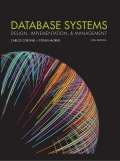
Database Systems: Design, Implementation & Management
13th Edition
ISBN: 9781337670562
Author: Coronel
Publisher: Cengage
expand_more
expand_more
format_list_bulleted
Concept explainers
Expert Solution & Answer
Chapter 16, Problem 38RQ
Explanation of Solution
Tablespaces:
A tablespace is a logical storage space to group related data file. A
The tablespace data is stored in one or more data files. Data files store the database data. When the DBA (Database Administrator) creates the database, Oracle automatically creates the tablespace and the database.
Some of the tablespace are described as follows,
- System tablespace – Used to store the data dictionary data.
- User’s tablespace - Used to store the table data created by end users.
- Temp tablespace – Used to store temporary table and the indexes created during the execution of the SQL statements...
Expert Solution & Answer
Trending nowThis is a popular solution!

Students have asked these similar questions
How can I perform Laplace Transformation when using integration based on this?
Write an example of a personal reflection of your course.
- What you liked about the course.
- What you didn’t like about the course.
- Suggestions for improvement.
Course: Information and Decision Sciences (IDS)
The Reflection Paper should be 1 or 2 pages in length.
How can I perform Laplace Transformation when using integration ?
Chapter 16 Solutions
Database Systems: Design, Implementation & Management
Ch. 16 - Prob. 1RQCh. 16 - Prob. 2RQCh. 16 - Prob. 3RQCh. 16 - Prob. 4RQCh. 16 - Suppose that you are a DBA. What data dimensions...Ch. 16 - How and why did database management systems become...Ch. 16 - Using a single sentence, explain the role of...Ch. 16 - Prob. 8RQCh. 16 - Prob. 9RQCh. 16 - Prob. 10RQ
Ch. 16 - Prob. 11RQCh. 16 - Prob. 12RQCh. 16 - Prob. 13RQCh. 16 - Prob. 14RQCh. 16 - Prob. 15RQCh. 16 - Prob. 16RQCh. 16 - Prob. 17RQCh. 16 - Prob. 18RQCh. 16 - What DBA activities support end users?Ch. 16 - Prob. 20RQCh. 16 - Prob. 21RQCh. 16 - Prob. 22RQCh. 16 - Prob. 23RQCh. 16 - Prob. 24RQCh. 16 - Prob. 25RQCh. 16 - Prob. 26RQCh. 16 - Prob. 27RQCh. 16 - Prob. 28RQCh. 16 - Prob. 29RQCh. 16 - Prob. 30RQCh. 16 - Define the concept of a data dictionary, and...Ch. 16 - Using SQL statements, give some examples of how...Ch. 16 - Prob. 33RQCh. 16 - Prob. 34RQCh. 16 - Prob. 35RQCh. 16 - How have cloud-based data services affected the...Ch. 16 - What tool is used in Oracle to create users?Ch. 16 - Prob. 38RQCh. 16 - Prob. 39RQCh. 16 - Prob. 40RQCh. 16 - Prob. 41RQ
Knowledge Booster
Learn more about
Need a deep-dive on the concept behind this application? Look no further. Learn more about this topic, computer-science and related others by exploring similar questions and additional content below.Similar questions
- I need help in explaining how I can demonstrate how the Laplace & Inverse transformations behaves in MATLAB transformation (ex: LIke in graph or something else)arrow_forwardYou have made the Web solution with Node.js. please let me know what problems and benefits I would experience while making the Web solution here, as compared to any other Web solution you have developed in the past. what problems and benefits/things to keep in mind as someone just learningarrow_forwardPHP is the server-side scripting language. MySQL is used with PHP to store all the data. EXPLAIN in details how to install and run the PHP/MySQL on your computer. List the issues and challenges I may encounter while making this set-up? why I asked: I currently have issues logging into http://localhost/phpmyadmin/ and I tried using the command prompt in administrator to reset the password but I got the error LOCALHOST PORT not found.arrow_forward
arrow_back_ios
SEE MORE QUESTIONS
arrow_forward_ios
Recommended textbooks for you
 A Guide to SQLComputer ScienceISBN:9781111527273Author:Philip J. PrattPublisher:Course Technology Ptr
A Guide to SQLComputer ScienceISBN:9781111527273Author:Philip J. PrattPublisher:Course Technology Ptr Database Systems: Design, Implementation, & Manag...Computer ScienceISBN:9781305627482Author:Carlos Coronel, Steven MorrisPublisher:Cengage Learning
Database Systems: Design, Implementation, & Manag...Computer ScienceISBN:9781305627482Author:Carlos Coronel, Steven MorrisPublisher:Cengage Learning Database Systems: Design, Implementation, & Manag...Computer ScienceISBN:9781285196145Author:Steven, Steven Morris, Carlos Coronel, Carlos, Coronel, Carlos; Morris, Carlos Coronel and Steven Morris, Carlos Coronel; Steven Morris, Steven Morris; Carlos CoronelPublisher:Cengage Learning
Database Systems: Design, Implementation, & Manag...Computer ScienceISBN:9781285196145Author:Steven, Steven Morris, Carlos Coronel, Carlos, Coronel, Carlos; Morris, Carlos Coronel and Steven Morris, Carlos Coronel; Steven Morris, Steven Morris; Carlos CoronelPublisher:Cengage Learning

A Guide to SQL
Computer Science
ISBN:9781111527273
Author:Philip J. Pratt
Publisher:Course Technology Ptr

Database Systems: Design, Implementation, & Manag...
Computer Science
ISBN:9781305627482
Author:Carlos Coronel, Steven Morris
Publisher:Cengage Learning

Database Systems: Design, Implementation, & Manag...
Computer Science
ISBN:9781285196145
Author:Steven, Steven Morris, Carlos Coronel, Carlos, Coronel, Carlos; Morris, Carlos Coronel and Steven Morris, Carlos Coronel; Steven Morris, Steven Morris; Carlos Coronel
Publisher:Cengage Learning



SQL Basics for Beginners | Learn SQL | SQL Tutorial for Beginners | Edureka; Author: edureka;https://www.youtube.com/watch?v=zbMHLJ0dY4w;License: Standard YouTube License, CC-BY